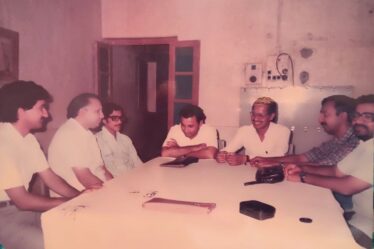
That old black phone—solid, heavy, a relic of a time when voices travelled through wires, not airwaves. Each number on its dial, a small circle, waiting for a finger to spin it. No speed dial, no saved contacts—just memory and precision. Calls were brief, words measured. Every minute cost money.
The phone perched on a wooden stool, its surface stained with old paint, a silent witness to hurried conversations and careful calculations. Behind it, a rusted almirah, its peeling paint revealing layers of time. Pinned to its surface, scraps of paper, hastily scrawled numbers—perhaps the lifeline of an institution.
And then, standing tall, staring straight into the camera, is Nalinbhai Mehta.
The 1970s. MGIMS, Sevagram, still in its infancy. Budgets tight, dreams enormous. Among the architects of this institution, five held the reins. Nalinbhai was one of them.
White khadi, unpressed but dignified. A square face, a broad jaw—firm, unyielding. Eyes that missed nothing, always scanning ledgers, tracking every paisa. His voice, deep and deliberate, cut through boardroom murmurs. Deans listened. Medical superintendents nodded. Because behind every number was a principle. Behind every rupee, accountability.
Frugality was his creed. Not a virtue, but a necessity. Not a habit, but a way of life. A rupee saved was a rupee strengthened. He allowed no waste, tolerated no laxity. Procedures were sacred. Transparency, non-negotiable. Attempts at shortcuts met his booming voice and an unflinching gaze. Few dared.
He ruled the accounts with an iron grip, but it was not fear that commanded respect—it was trust. Dr. Sushila Nayar, the institute’s founding president, saw in him a sentinel of financial integrity. She gave him free rein, knowing he would never waver. The hospital, the college—both rested on strong financial pillars because he made sure of it.
Outside the office, his life mirrored his work. Simple. Frugal. Purposeful. No extravagance, no indulgence. Because every rupee saved was another rupee for the institution. And for him, MGIMS was not just a workplace. It was a mission.
July 2000. He left, six months before Sushila Nayar. But his legacy endures, etched in balance sheets, in policies, in the pink financial health of the institution he guarded so fiercely.
MGIMS stands, in part, because he stood firm.
